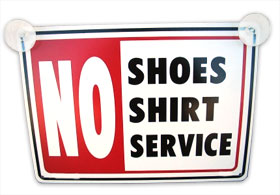Setting boundaries for behavior in Social Media
Why Tim O’Reilly’s Code of Conduct Won’t Work
 Tim O’Reilly has put forth a draft of a recommended Blogging Code of Conduct for bloggers that are interested in maintaining civil discourse in the comments on their blogs. He’s done so in response to a recent incident of cyber-bullying in the blogosphere that has troubled him, and many other bloggers (including myself) profoundly.
Tim O’Reilly has put forth a draft of a recommended Blogging Code of Conduct for bloggers that are interested in maintaining civil discourse in the comments on their blogs. He’s done so in response to a recent incident of cyber-bullying in the blogosphere that has troubled him, and many other bloggers (including myself) profoundly.
However well-intentioned O’Reilly’s efforts, a one-size fits all Code of Conduct and the inherent social pressure for trendsetting bloggers to subscribe to such a code is backfiring.
One problem with the current draft of the Code of Conduct is that it does not reflect the diversity of social expectations inherent in communities across the blogosphere nor acknowledge that individual bloggers may have enormously different approaches when dealing with social transgressors that are difficult to codify.
95% of bloggers probably find themselves somewhere in the great grey continuum between “Civility Enforced” and “Anything Goes” (the two badges that accompany the draft Code of Conduct).

The end result is a draft Code of Conduct that is difficult for many bloggers to actually subscribe to wholeheartedly.
Setting boundaries for behavior is not a new thing
Communities have struggled to find the best ways in setting boundaries for behavior as long as there are communities. Robert Scoble was quoted in the New York Times that “As a writer, it makes me feel like I live in Iran”. While this may inadvertently trivialize the harshness of Iranian social codes (where women that have been raped can be executed for the crime of adultery), it does bring the point home. The blogosphere is inherently free-spirited and free-wheeling like the Wild West and each community needs to govern itself in the way that those responsible for it see fit.
The importance of signage
While some restaurants may require you to have a tie and a sportcoat, other’s won’t care if you walk in half naked. When you go to the beach, it is nice to know if it is clothing-optional so that you no what to expect. All of this is handled through signs.
What Tim O’Reilly could have done to have a greater impact
 As one of the leaders of Web 2.0, there is much:
As one of the leaders of Web 2.0, there is much:
- He could have encouraged bloggers to develop their own code of conducts.
- He could have gathered graphic designers together to try to come up with a standard badge that would link to their own codes of conduct, so that people would be aware what to expect. Something like what you see here, but designed by someone more talented than me.
- He could have provided example codes of conducts that could be remixed and mashed up a la Creative Commons licenses.
The great thing about the blogosphere is we don’t need any one person to set the agenda. If you want to help clarify the code of conduct for your visitors, take your own initiative and specify it in whatever manner works for you and your community.
Whatever we do, the bullying will continue
Ironically, neither Tim O’Reilly’s Code of Conduct nor my recommended approaches to the problem will really do a thing to address the problems which arose in issue that spurred all of this, as it occurred primarily in a blog that was designed specifically to bully particular individuals. The only realistic solutions available in these cases are via law enforcement if a legal line has been crossed or in shining light on the behavior in order to ostracize the individuals responsible for the behavior that the masses find offensive, while trying to avoid the injustice of mob rule.
UPDATE: Great takes on the whole mess from Nick Wilson, Jeff Jarvis and Andy Beal. Dan Gilmor as well, who had dipped into similar shark pool a while back.
UPDATE II: O’Reilly has responded to this mess — my thoughts here.
